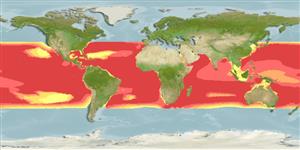>
Aulopiformes (Grinners) >
Notosudidae (Waryfishes)
Etymology: Ahliesaurus: Because of Dr. Ernest Ahli, born in Berlin, 1898 + Greek, sauros =lizard (Ref. 45335).
Environment: milieu / climate zone / depth range / distribution range
Écologie
marin bathypélagique; profondeur 0 - 2000 m (Ref. 35509). Deep-water; 40°N - 40°S
Tropical and subtropical Atlantic, southwestern Indian and central South Pacific oceans.
Taille / Poids / Âge
Maturity: Lm ? range ? - ? cm
Max length : 26.9 cm SL mâle / non sexé; (Ref. 6552)
Épines dorsales (Total): 0; Rayons mous dorsaux (Total): 10-11; Épines anales 0; Rayons mous anaux: 19 - 21. Olive brown in color, edges of scale pockets blackish; 2 black bands formed by peritoneum showing through body wall; blackish triangular spot on caudal base (Ref. 6602).
Mesopelagic to bathypelagic (Ref. 6602). Sometimes taken at depths greater than 500 m (Ref. 6602). Feeds on smaller plankton, mainly copepods. Hermaphrodite, spawning probably occurs in the North Atlantic in a belt stretching across the ocean in subtropical latitudes. Specimens approaching sexual maturity lose their teeth and gillrakers completely (Ref. 6689) suggesting semelparity (RF).
Life cycle and mating behavior
Maturité | Reproduction | Frai | Œufs | Fécondité | Larves
Krefft, G., 1990. Notosudidae. p. 361-364. In J.C. Quero, J.C. Hureau, C. Karrer, A. Post and L. Saldanha (eds.) Check-list of the fishes of the eastern tropical Atlantic (CLOFETA). JNICT, Lisbon; SEI, Paris; and UNESCO, Paris. Vol. 1. (Ref. 6552)
Statut dans la liste rouge de l'IUCN (Ref. 130435)
Menace pour l'homme
Harmless
Utilisations par l'homme
Pêcheries: sans intérêt
Plus d'informations
Noms communsSynonymesMétabolismePrédateursÉcotoxicologieReproductionMaturitéFraiRassemblement de ponteFéconditéŒufsDéveloppement de l'œuf
Taille/ÂgeCroissanceLongueur-poidsLongueur-longueurFréquences de longueursMorphométrieMorphologieLarvesDynamique des populations larvairesRecrutementAbondanceBRUVS
RéférencesAquacultureProfil d'aquacultureSouchesGénétiqueElectrophoresesHéritabilitéPathologiesTraitementNutrientsMass conversion
CollaborateursImagesStamps, Coins Misc.SonsCiguateraVitesseType de nageSurface branchialeOtolithesCerveauxVision
Outils
Articles particuliers
Télécharger en XML
Sources Internet
Estimates based on models
Preferred temperature (Ref.
123201): 5.5 - 15, mean 9.1 °C (based on 1365 cells).
Phylogenetic diversity index (Ref.
82804): PD
50 = 0.7500 [Uniqueness, from 0.5 = low to 2.0 = high].
Bayesian length-weight: a=0.00288 (0.00120 - 0.00692), b=3.18 (2.96 - 3.40), in cm total length, based on LWR estimates for this (Sub)family-body shape (Ref.
93245).
Niveau trophique (Ref.
69278): 3.0 ±0.00 se; based on food items.
Résilience (Ref.
120179): Faible, temps minimum de doublement de population : 4,5 à 14 années (Assuming semelparity and tm>5).
Fishing Vulnerability (Ref.
59153): Low vulnerability (23 of 100).
